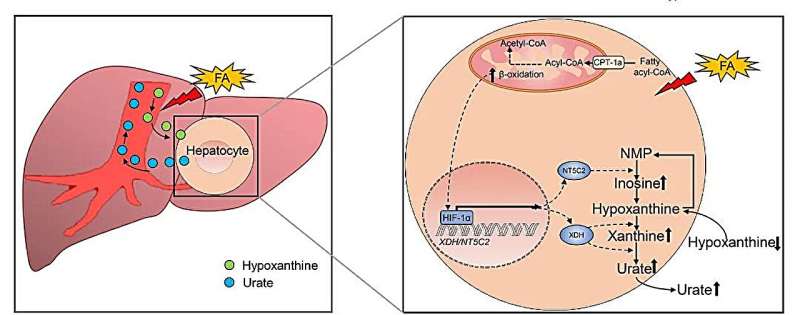This article has been reviewed according to Science X's editorial process and policies. Editors have highlighted the following attributes while ensuring the content's credibility:
fact-checked
proofread
Researchers advance understanding of mechanism linking hyperuricemia to hypertriglyceridemia

Hyperuricemia (HU) is diagnosed when the levels of urate in the blood exceed 420 μmol/L, the saturated concentration of urate. In mainland China, the prevalence of HU exceeds 17.7% in the adult population, affecting over 185 million individuals.
HU has become the fourth most common chronic metabolic condition in China, following hyperlipidemia, hyperglycemia, and hypertension. HU not only triggers gout but also increases the risk of various metabolic diseases, including obesity, diabetes, cardiovascular and cerebrovascular diseases, hypertension, and kidney disease.
Among the 25 million gout patients in China, more than half exhibit abnormal blood lipid levels. Although preliminary analysis suggests that hypertriglyceridemia may be a causal factor for HU, the underlying mechanism has remained elusive.
Recently, Professor Yin Huiyong's team unveiled a mechanism by which fatty acid oxidation induces hepatic urate synthesis and HU. Their findings were published online in the journal Life Metabolism entitled "Fatty acid oxidation-induced HIF-1α activation facilitates hepatic urate synthesis through upregulating NT5C2 and XDH."
They reported that in metabolic disorders, such as hypertriglyceridemia and non-alcoholic fatty liver disease, hepatic fatty acid oxidation induces activation of hypoxia-inducible factor-1α (HIF-1α), which transcriptionally activates the urate synthesis pathway involving xanthine dehydrogenase (XDH) and cytosolic 5´-nucleotidase II (NT5C2). This mechanism represents the first discovery of a bridging role between lipid metabolism and purine metabolism pathways in metabolic diseases, offering potential strategies for the prevention and treatment of hyperlipidemia and HU.
This study was carried out through collaborations between the research team led by Professor Yin from City University of Hong Kong/Shanghai Institute of Nutrition and Health, Chinese Academy of Sciences, the team of Professor Xia Qiang from Renji Hospital affiliated with Shanghai Jiao Tong University School of Medicine, and the team led by Professor Li Changgui at Qingdao University Affiliated Hospital. Dr. Liang Ningning, a Research Assistant in the Department of Biomedical Sciences at the City University of Hong Kong, and Dr. Yuan Xuan from the Affiliated Hospital of Qingdao University are the co-first authors, while Professors Yin, Professor Xia, and Professor Li are the co-corresponding authors.
More information: Ningning Liang et al, Fatty acid oxidation-induced HIF-1α activation facilitates hepatic urate synthesis through upregulating NT5C2 and XDH, Life Metabolism (2024). DOI: 10.1093/lifemeta/loae018




















